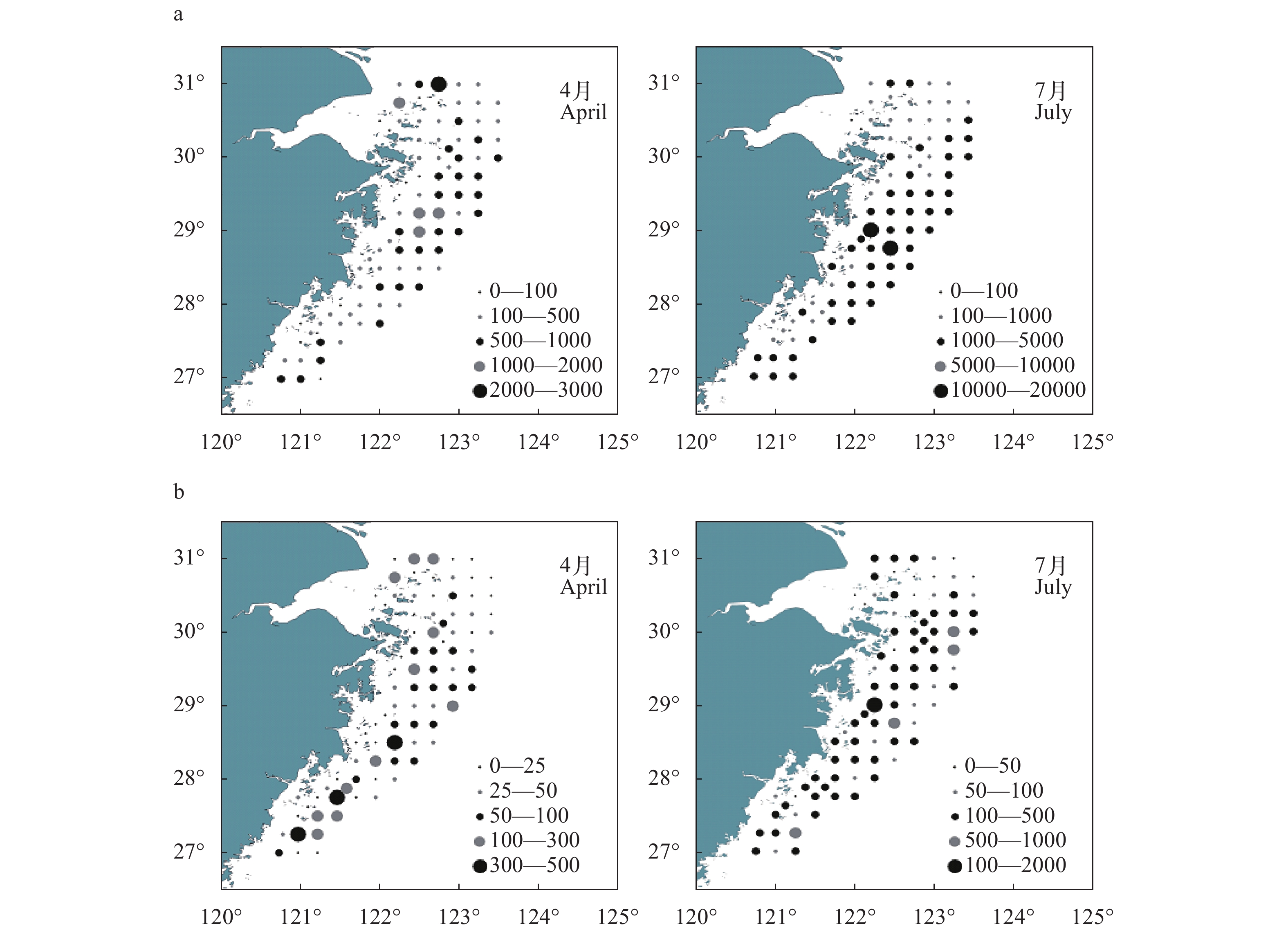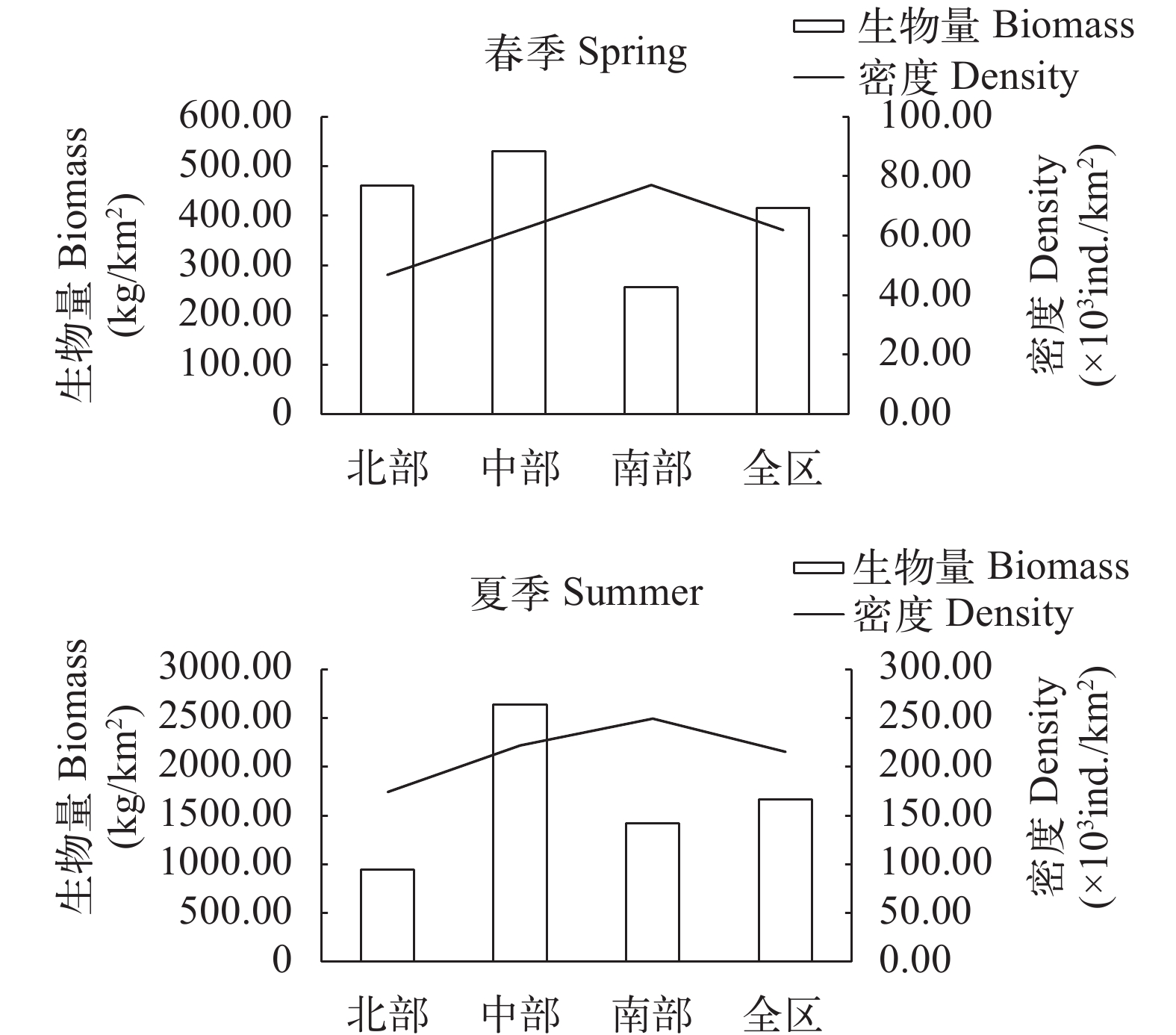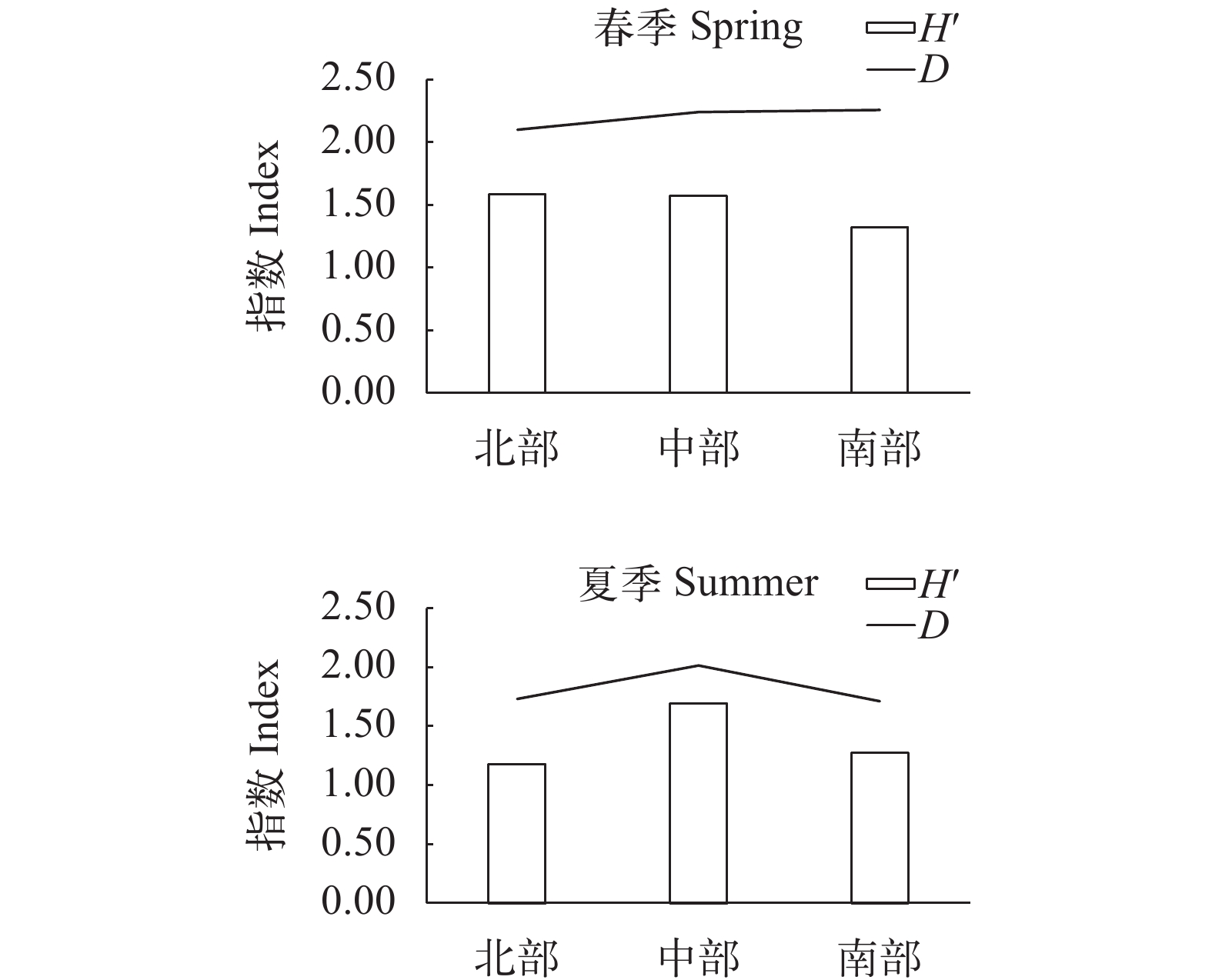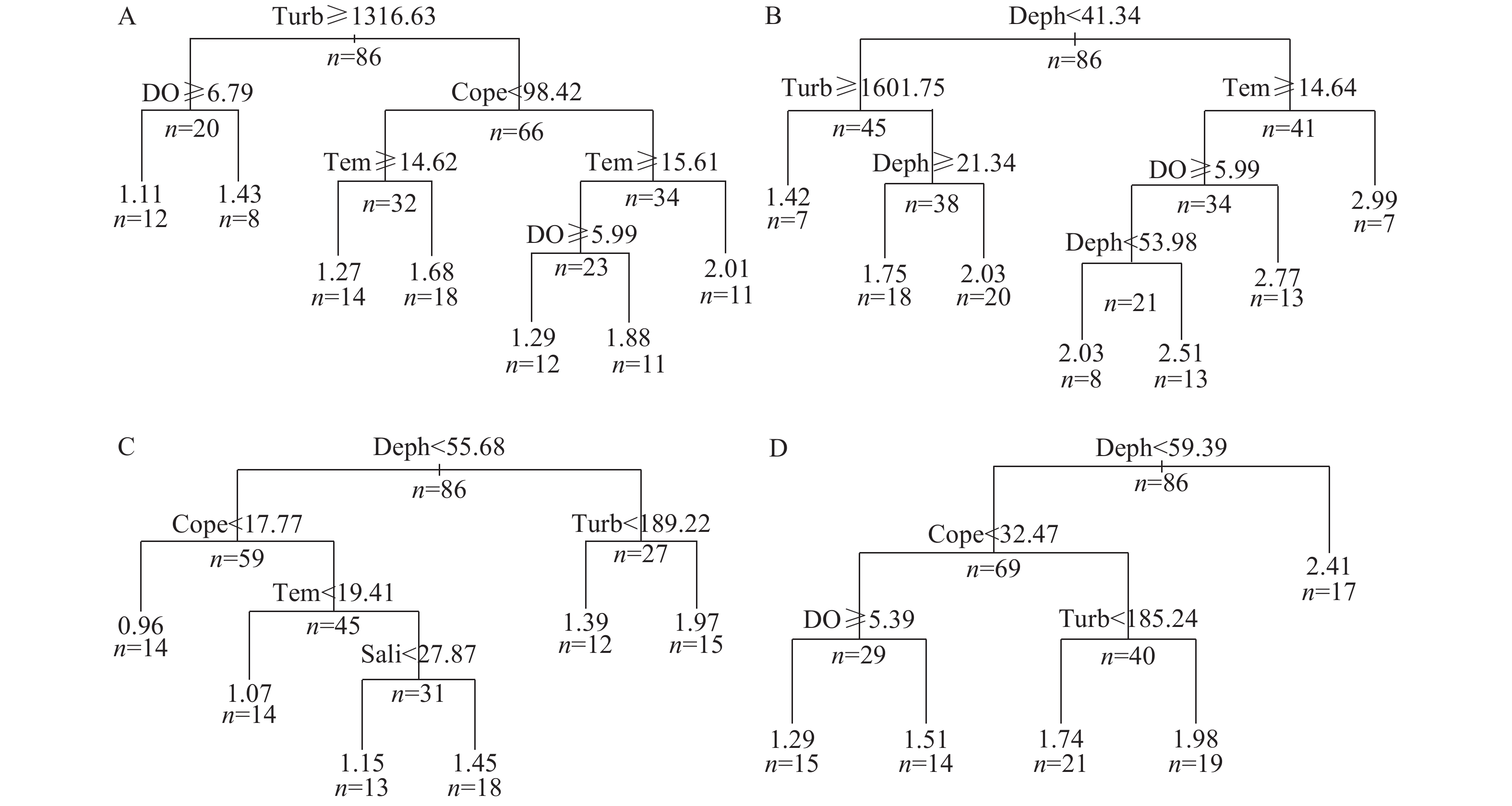STUDY ON FISH RESOURCES AND COMMUNITY DIVERSITY DURING SPRING AND SUMMER IN THE COASTAL SPAWNING GROUND OF ZHEJIANG PROVINCE, CHINA
-
摘要: 根据2015年4月(春季)和7月(夏季)在浙江沿岸产卵场进行的渔业资源底拖网调查资料, 采用多重比较(LSD)和分类回归树(CART)方法研究了浙江沿岸产卵场春、夏季群落多样性和鱼类资源的变化, 以及多样性与诸多环境因子(生物和非生物)的关系, 结果表明: (1)该水域春季共捕获鱼类92种, 隶属17目50科77属, 夏季捕获鱼类114种, 隶属16目59科92属; (2)春季全区生物量平均为434.40 kg/km2, 中部和南部生物量差异极显著(P=0.005), 全区尾数密度平均为58.42千尾/km2, 不同区域差异不显著; 夏季全区生物量平均为1532.73 kg/km2, 北部生物量与中部差异极显著(P=0.000), 与南部差异显著(P=0.017), 全区尾数密度平均为205.50千尾/km2, 北部尾数密度与南部差异显著(P=0.034), 其他区域间差异不显著; (3)春季H′平均值为1.52, D平均值为2.18, 北部和南部D差异显著(P=0.048), 其他区域间H′和D差异均不显著; 夏季H′平均值为1.34, D平均值为1.81, 中部和北部H′差异极显著(P=0.000), 和南部差异接近极显著(P=0.01), 北部和中部D差异显著(P=0.039), 其他区域间差异不显著; (4)CART分析表明, 影响春季多样性和丰富度的主要因素有水深、浊度和溶氧; 秋季多样性水平主要受的水深、桡足类、温度和浊度的影响; (5)从空间和时间上与其他水域的多样性水平相比较得出, 在空间上, 纬度与H′并不存在简单的线性关系, 但当纬度跨度比较大时, 低纬度水域的H′值明显高于高纬度水域的H′值; 在时间上, 多样性水平较2008年明显升高, 但与2011年的调查结果相近, 表明产卵场(南部)近几年渔业生态环境处于相对较稳定的状态。Abstract: The fish resources and community diversity, and their relationships with the biotic and abiotic environmental factors in spawning ground of Zhejiang province (China) were studied. In this research, data were collected from bottom trawl surveys in spring and summer of 2015 by the least square deviation (LSD) and classification and regression tree. In spring, a total of 92 fish species were sampled in the survey, belonging to 77 genera, 54 families, and 17 orders. In summer, a total of 115 fish species were captured, belonging to 92 genera, 62 families, and 16 orders. In spring, the average value of biomass was 434.40 kg/km2 in the whole spawning ground, and the difference of biomass between middle and southern region was statistically significant (P=0.032). The average value of abundance density was 58.42 kg/km2 in the whole region, and the difference between northern and southern region was statistically significant (P=0.040). In summer, the average value of biomass was 1532.73 kg/km2 in the whole spawning ground, and a significant difference was found between northern and middle region (P=0.010), between northern and southern region was significant (P=0.026). The average value of abundance density was 205.50 kg/km2 in the whole region, and the differences between northern and middle region, as well as northern and southern region were both significant (P=0.041, P=0.011). The average values of H′ and D were 1.52 and 2.18 in Spring, correspondingly, the average values of H′ and D were 1.34 and 1.81 in summer, respectively. The classification and regression tree indicated that the main factors affecting the diversity and richness index were depth and turbidity in spring, while the main factors affecting the community diversity level were depth, copepods, temperature, and turbidity in summer. On space, no simple linear relationship was found between latitude and H′, however, H′ value in low latitude waters was significantly higher than that in the high latitude waters when the latitude span was very large. Once, the diversity level was remarkably improved compared with 2008, however, that was closed to the corresponding level in 2011, which indicated that the ecological and environmental factors on the coastal spawning ground of Zhejiang province was relatively stable in recent years.
-
浙江沿岸产卵场由舟山渔场、鱼山渔场和温台渔场组成, 受台湾暖流、东海沿岸流及长江冲淡水的影响, 饵料生物丰富, 是多种鱼类重要的产卵场和索饵场, 在东海区乃至全国的海洋渔业中占有重要地位[1]。
然而, 由于捕捞结构不合理和酷鱼滥捕, 近二十年来浙江渔场渔业资源结构发生较大变化, 整体资源状况恶化, 表现为重要经济种类[如带鱼(Trichiurus lepturus)、银鲳(Pampus argenteus)、刺鲳(Psenopsis anomala)、小黄鱼(Larimichthys polyactis)等]的产卵亲体数量和幼鱼发生量显著下降, 渔获物规格越来越小, 幼鱼比例逐渐增高等(浙江省海洋水产研究所内部调查资料)。此外, 涉海工程建设也严重影响了沿岸产卵场和索饵场的水域生态环境, 从而间接地影响了渔业资源的恢复。 据现有的资料得知, 多年来虽有学者对浙江近岸部分水域的鱼类资源做过调查[2—4], 但对浙江沿岸产卵场渔业资源现状未开展过系统的专业研究。因此, 在渔业资源保护和群落多样性日益被世界各国重视的今天, 有必要对浙江沿岸产卵场的鱼类资源和多样性的现状进行研究。
本文根据2015年4月(春季)和7月(夏季)在浙江沿岸产卵场的底拖网调查资料, 对整个产卵场的鱼类群落结构特征进行了分析, 首次探讨了不同区域鱼类资源及多样性的差异, 并全面分析了鱼类群落多样性与诸多环境因子(生物和非生物)的关系。为“浙江渔场修复振兴”效果评价提供数据支撑, 同时也为日益增多的海洋工程建设和海洋环境污染对渔业资源的影响评估提供依据。
1. 材料与方法
1.1 数据收集
本文数据来源于2015年4月(春季)和7月(夏季)在浙江沿岸产卵场保护区(27°00′—31°00′N, 120°45′—123°30′E)的渔业资源底拖网调查。在该海域共设置86个调查站位(图 1), 调查船只为“浙普渔70 013”号, 调查网具为单拖网, 网口周长50 m(622目×8 cm)、网身长48 m、囊网目大2.5 cm。捕获的渔获物全部低温冰鲜保存, 带回实验室进行鉴定, 每种鱼类鉴定到种[5, 6], 调查和样品处理分析参考《海洋调查规范》[7]。数据分析前, 将各站位鱼类渔获量换算成拖速3.0节的单位(1h)网次渔获量。
同步调查的环境因子有水温、深度、盐度、pH、浊度(Turb)、电导率(Cond)、叶绿素a(Chl. a)和溶解氧(DO), 上述指标用便携式水质分析仪(YSI 6 600, USA)现场测定。在采集渔获物的同时, 浮游动物样品也同步收集, 收集和处理等全部过程均按《海洋调查规范-海洋生物调查》[7]进行。浮游动物分为端足类(Amphipods)、糖虾类(Mysids)、磷虾类(Euphausiid)、桡足类(Copepods)、十足类(Decapod)和浮游幼体(Planktonic larvae)六大类。为了比较不同区域鱼类群落多样性及资源密度的差异, 本文将舟山渔场(29°30′—31°)归为北部区域(含31°), 鱼山渔场(28°—29°30′)归为中部区域(含29°30′), 温台渔场(28°以南)归为南部区域。
1.2 数据处理
拖网资源密度的估算采用扫海面积法[8]:
${\rho _i} = \frac{1}{n}\sum\limits_{j = 1}^n {{C_j}/D(1 - E){V_j}{T_j}} $


式中: ρi为i季节的平均资源密度(kg/km2或ind./km2), n为i季节的总拖网数(站位数), Cj为i季节j站位的网次渔获重量(kg)或尾数(ind.), D为网口水平扩张宽度(km)(拖速5.19 km/h时本网具D为5.20×10–3 km), Vj为i季节j站位的平均拖速(km/h), Tj为i季节j站位的拖网时间(h), E为逃逸率(取0.5[4])。
This page contains the following errors:
error on line 1 at column 1: Start tag expected, '<' not foundBelow is a rendering of the page up to the first error.
本文利用分类回归树(Classification and Regression Tree, CART)[13]方法来预测鱼类多样性变化的最优环境变量。CART最大的特点就是它不要求因变量和自变量之间有线性或非线性关系, 它是将自变量不停地进行拆分, 来预测因变量的可能发展趋势, 在每次的拆分过程中会自动选择最优划分变量。在初始的回归树构建完成后, 我们还需对它进行剪枝(‘pruning’ branches), 因为若不加任何限制, 最终生成的树必和原始数据完全拟合。本文利用1-SE规则来进行剪枝, 即预测误差在“最小误差±1个相应标准差”范围内, 然后在此范围内选取尽量小的复杂性参数(Complexity parameter), 以它为依据进行剪枝, 其中预测误差是通过交叉验证(Cross-validated)获得[14], 分类回归树是在R软件中构建。
不同区域优势种大小、资源密度和多样性比较采用单因素方差(one-way ANOVA)和LSD多重比较分析, 为保证方差齐性, 所有数据在分析前进行log(x+1)转换, 数据处理在Excel 2010和SPSS 16.0中进行。
2. 结 果
2.1 种类组成
春季拖网调查共采集鱼类样本92种, 隶属17目50科77属, 其中鲈形目种类数最多, 占总种数的44.57%。鲼形目、灯笼鱼目、鲤形目、鲀形目、海鲂目、鲻形目、鼬鳚目和颌针鱼目种类数最少, 分别只有1种。
夏季共采集到底层鱼类样本114种, 隶属16目59科92属, 种类数较春季明显增多, 同样鲈形目鱼类占多数, 有49种, 占总种数的42.98%。鼠鲨目 、鳐目、灯笼鱼目、海鲇目、海鲂目和鼬鳚目种类数最少, 均只有1种(表 1)。
表 1 底拖网捕获的鱼类种类Table 1. Fish species captured by bottom trawl目Order 科Family 种Species 春季Spring 夏季Summer 鼠鲨目Lamniformes 双髻鲨科Sphyrnidae 鎚头双髻鲨Sphyrna zygaena * 鳐目Rajiformes 鳐科Rajidae 孔鳐Raja porpsa * 鲼形目Myliobatiformes 魟科Dasyatidae 光魟Dasyatis laevigatus * 鲱形目Clupeiformes 鲱科Clupeidae 青鳞小沙丁鱼Sardinella zunasi * 斑鰶Konosirus punctatus * 鳓鱼Ilisha elongata * 鳀科Engraulidae 中华小公鱼Stolephorus chinensis * 赤鼻棱鳀Thrissa kammakensis * * 汉氏棱鳀Thryssa hamiltonii * 中颌棱鳀Thrissa mystax * * 黄鲫Setipnna taty * 凤鲚Coilia mystus * * 刀鲚Coilia nasus * * 鳀Engraulis japonicus * * 灯笼鱼目Scopeliformes 灯笼鱼科Myctophidae 七星底灯鱼Benthosema pterotum * * 鲇形目Siluriformes 海鲇科Ariidae 中华海鲇Arius sinensis * * 鳗鲡目Anguilliformes 鳗鲡科Anguillidae 日本鳗鲡Anguilla japonica * 康吉鳗科Congridae 星康吉鳗Conger myriaster * * 拟穴奇鳗Alloconger anagoides * * 黑尾吻鳗Rhynchoconger ectenurus * * 短尾吻鳗Rhynchoconger brevirostris * * 海鳗科Muraenesocidae 海鳗Muraenesox cinereus * * 前肛鳗科Dysommidae 前肛鳗Dysomma anguillaris * * 蛇鳗科Ophichthyidae 豆齿鳗Pisoodonophis cancrivorus * * 食蟹豆齿鳗Pisoodonophis cancrivorus * 尖吻蛇鳗Ophichthys apicalis * * 蚓鳗科Moringuidae 大头蚓鳗Moringua macrocephalus * 鳕形目Gadiformes 犀鳕科Bregmacerotidae 麦氏犀鳕Bregmaceros macclellandii * * 长尾鳕科Macrouridae 多棘腔吻鳕Coelorhynchus multispinulosus * * 深海鳕科Moridae 日本小褐鳕Physiculus japonicus * 海龙目Syngnathiformes 烟管鱼科Fistulariade 毛烟管鱼Fistularia villosa * 海龙科Syngnathidae 舒氏海龙Syngnathus schlegeli * 尖海龙Syngnathus acus * * 日本海马Hippocampus japonicus * 海鲂目Zeiformes 海鲂科Zeidae 日本海鲂Zeus japonicus * * 鲻形目Mugiliformes 鲻科Mugilidae 鲻鱼Mugil cephalus * 2.2 优势种及其大小
春季北部的优势种为龙头鱼(Harpodon nehereus)、矛尾虾虎鱼(Chaeturichthys stigmatias)、中华栉孔虾虎鱼(Ctenotrypauchen chinensis)和凤鲚(Coilia mystus), 中部和南部的优势种都为龙头鱼(H. nehereus)和矛尾虾虎鱼(C. stigmatias), 三区域共同的优势种为龙头鱼(H. nehereus)和矛尾虾虎鱼(C. stigmatias)。夏季北部的优势种为小黄鱼(Larimichthys polyactis)、龙头鱼(H. nehereus)、矛尾虾虎鱼(C. stigmatias)和绿鳍鱼(Chelidonichthys kumu), 中部和南部优势种都为小黄鱼(L. polyactis)、龙头鱼(H. nehereus)和白姑鱼(Argyrosomus argentatus), 三区域共同的优势种为小黄鱼(L. polyactis)和龙头鱼(H. nehereus)。经单因素方差和多重比较分析得出, 春季龙头鱼大小自北向南有明显递增趋势, 但差异不显著(P>0.05), 中部矛尾虾虎鱼较其他两区域大, 但是差异也不显著(P>0.05); 夏季仅北部和南部小黄鱼差异极显著(P<0.01), 其他区域间差异不显著; 并且其他不同区域同一种类间差异都不显著(P>0.05)(表 2)。
表 2 不同区域优势种的IRI指数及重量Table 2. The index of relative importance (IRI) and weight of dominant species in different regions区域Region 种类Species 春季Spring 夏季Summer IRI 重量(g/尾) IRI 重量(g/尾) 北部Northern region 小黄鱼P. polyactis — — 3627.55 7.12 龙头鱼H. nehereus 3446.62 15.23 1150.35 24.12 矛尾虾虎鱼C. stigmatias 1201.51 0.44 4090.42 1.53 中华栉孔虾虎鱼C. chinensis 1180.47 6.01 — — 凤鲚C. mystus 1081.99 3.76 — — 绿鳍鱼C. kumu — — 1003.25 22.03 中部Middle region 小黄鱼P. polyactis — — 7280.37 10.55 龙头鱼H. nehereus 3354.27 18.90 1648.85 32.10 矛尾虾虎鱼C. stigmatias 4145.61 0.73 — — 白姑鱼A. argentatus — — 1342.98 1.37 南部Sorthern region 小黄鱼P. polyactis — — 1244.41 11.79 龙头鱼H. nehereus 3577.35 24.22 1511.13 25.44 矛尾虾虎鱼C. stigmatias 8596.96 0.41 — — 白姑鱼A. argentatus — — 5830.28 3.75 2.3 资源密度变化
春季调查的资源密度数据显示, 在生物量方面, 全区生物量最大值为2144.66 kg/km2, 最小值为4.40 kg/km2, 平均为434.40 kg/km2。从不同区域来看, 中部的生物量最高, 北部次之, 南部最低。单因素方差分析结果表示不同区域生物量差异显著(P=0.017<0.05), 多重比较结果显示, 仅中部和南部的生物量差异极显著(P=0.005), 其他区域间差异不显著(P>0.05)。在尾数密度方面, 全区尾数密度最大值为435.85千尾/km2, 最小值为1.24 千尾/km2, 平均为58.42千尾/km2。从不同区域看, 从北到南尾数密度呈直线上升趋势。单因素方差分析结果显示, 不同区域尾数密度差异不显著(P>0.05)(图 2、图 3)。
夏季调查的资源密度数据显示, 在生物量方面, 全区生物量最大值为13 692.92 kg/km2, 最小值为40.20 kg/km2, 平均为1 532.73 kg/km2。夏季生物量显著大于春季(P=0.000<0.01)。从不同区域来看, 中部的生物量最高, 南部次之, 北部最低。单因素方差分析结果表示不同区域生物量差异极显著(P=0.001), 多重比较的结果显示, 北部与中部生物量差异极显著(P=0.000), 与南部差异显著(P= 0.017), 但是中部与南部没有显著性差异(P=0.310)。尾数密度方面, 全区尾数密度最大值为1 397.33 千尾/km2, 最小值为5.31 千尾/km2, 平均为205.50千尾/km2。夏季尾数密度显著大于春季(P=0.000<0.01)。从不同区域看, 南部比中部略高, 北部最低。单因素方差分析结果显示, 北部尾数密度与南部差异显著(P=0.034), 但是其他区域间差异不显著(图 2、图 3)。
2.4 多样性研究
不同区域的多样性 春季H′值的变化范围为0.17P<2.49, 平均值为1.52;D值变化范围为0.80—3.74, 平均值为2.18。单因素方差分析结果显示, 北部和南部D差异显著(P=0.048), 其他区域间H′和D差异均不显著(P>0.05)。
夏季H′值的变化范围为0.23—2.59, 平均值为1.34; D值变化范围为0.82—3.22, 平均值为1.81。单因素方差分析显示不同区域H′差异极显著(P=0.001), 多重比较结果显示北部和中部H′差异极显著(P=0.000), 中部和南部之间差异接近极显著(P=0.01), 北部和南部区域间差异不显著(P>0.05); 与H′不同, 仅北部和中部D差异显著(P=0.039), 其他区域间差异不显著(P>0.05)(图 4)。
多样性的CART分析 影响春季多样性指数主要的因素为浊度、DO、桡足类及温度, 影响丰富度主要的因素有水深、浊度、温度及DO。夏季多样性指数主要受水深、桡足类、浊度、温度和盐度的影响, 丰富度主要受水深、桡足类、溶氧和浊度的影响。
![]() 图 5 春、夏季多样性指数和丰富度指数的分类回归树A. 4月多样性指数; B. 4月丰富度指数; C. 7月多样性指数; D. 7月丰富度指数; Deph. 水深; Tem. 温度; Turb. 浊度; Cope .桡足类; DO. 溶解氧; Sali. 盐度Figure 5. Classification and regression tree of diversity and richness indexes in spring and summerA. Diversity index in April; B. Richness index in April; C. Diversity index in July; D. Richness index in July
图 5 春、夏季多样性指数和丰富度指数的分类回归树A. 4月多样性指数; B. 4月丰富度指数; C. 7月多样性指数; D. 7月丰富度指数; Deph. 水深; Tem. 温度; Turb. 浊度; Cope .桡足类; DO. 溶解氧; Sali. 盐度Figure 5. Classification and regression tree of diversity and richness indexes in spring and summerA. Diversity index in April; B. Richness index in April; C. Diversity index in July; D. Richness index in July3. 讨论
3.1 资源密度特征
春季是很多鱼类的产卵季节, 因此幼鱼发生量较高。调查期间在浙江沿岸产卵场保护区发现有十余种鱼类的幼体, 其中小黄鱼、绿鳍鱼和矛尾虾虎鱼数量最多。春季的资源密度调查结果显示, 南部尾数密度最高, 但却表现出生物量最低, 这可能是由于南部水域幼鱼比例非常高所致(幼鱼尾数密度占该区域总密度的69.18%)(表 3)。调查期间发现夏季幼鱼较少, 北部水域几乎没有出现幼鱼, 中部和南部水域仅发现一种鱼类幼体, 分别为黄姑鱼和白姑鱼。与春季相比, 夏季沿岸产卵场从北向南鱼类尾数密度的变化趋势相似, 都是逐渐增高, 但是生物量却呈现出北部相对减少, 南部相对增加的现象(图 3)。这可能有两方面原因, 一方面由于南部水域大量的幼体随着水温的升高, 生长迅速, 体重增加, 最后导致整个区域的生物量明显增加; 另一方面由于优势种小黄鱼在北部水域较小, 而在南部水域个体较大的缘故(表 2)。
表 3 春、夏季不同区域幼鱼主要参数比较Table 3. Comparing the main parameters of juvenile fishes belonging to different regions in spring and summer季节Season 地区Region 生物量Biomass (kg/km2) 比例Ratio (%) 尾数密度Density (千尾/km2) 比例Ratio (%) 重量Weight (g/尾) 春季Spring 北部 0.79 0.17 2.19 4.99 0.38 中部 3.15 0.61 4.81 8.18 0.63 南部 18.41 7.19 53.28 69.18 0.35 夏季Summer 北部 — — — — — 中部 0.6 0.03 0.71 0.32 0.84 南部 281.17 19.8 187.05 74.93 1.50 3.2 多样性变化
不同纬度及区域间多样性的比较 本文将研究结果从空间和时间跨度上分别与其他海域进行了比较(表 4), 得出的结果和结论如下: 从空间跨度上, 纬度与H′没有绝对的线性关系, 如春季从西大亚湾到东海中部(2001), H′随着纬度的递增而减小, 但随着纬度的继续增高, H′反而增大(调查时间较近的青岛海域和东海中部海域相比H′明显较大), 这与之前纬度越高, H′越低的研究结论不符。虽然纬度与H′的关系并非简单的线性关系, 但当纬度跨度比较大时, 低纬度水域的H′值还是明显高于高纬度水域的H′值, 如调查时间相近的西大亚湾海域H′值与辽东湾北部海域H′值相比, 春季大4.51倍, 夏季大1.59倍。从时间跨度上, 东海中部(浙江沿岸产卵场绝大部分包含在内)海域自2000年到2015年期间, 共进行了4次多样性研究, 结果表明自2000年到2008年, H′和D值逐渐下降, 2008年与2015年相比多样性水平呈上升状态。林楠等[1]指出2008年多样性下降是由于凶猛肉食性鱼类带鱼生物量明显增加和人为影响(捕捞及污染)的原因。2015年多样性水平明显升高, 我们推测是由于温度和饵料的影响。近年来, 由于全球气候变暖, 导致调查海域表层温度升高[25]。有研究表明, 2014年浙江沿岸水域表层平均温度较2009年有所上升, 伴随着温度的升高, 浮游动物的密度和生物量也随之上升(密度和生物量分别增加了57.77%和47.11%)[26]。底层鱼类大部分属于杂食性鱼类, 幼体或者有些成体的食物组成中包含大量的浮游动物[27], 因此, 2008年之后鱼类多样性的上升多半是由于调查海域的水温及生物饵料变化引起的。2015年产卵场南部海域的多样性水平(H′值1.32, D值2.26)与2011年的调查结果相近, 表明产卵场(南部)近几年渔业生态环境处于相对较稳定的状态。
表 4 与其他海域多样性比较Table 4. Comparing the fish diversity indices in different regions区域Region 纬度Latitude 经度Longitude 年份Year 指数Index 春季Spring 夏季Summer 文献Reference 辽东湾北部North of Liaodong Bay 40°10′—41°00′ 121°00′—122°15′ 2006—2007 H′w 0.39 1.20 [15] D 0.40 1.17 黄河口及其邻近水域Huanghe estuary and its adjacent area 37°30′—38°00′ 119°09′—119°30′ 2010 H′w — 1.36 [16] D — 1.27 莱州湾及其黄河口Laizhou Bay and the Yellow River Estuary 38°30′以南 118°30′—120°30′ 2011—2012 H′w 1.85 1.59 [17] Dw 1.93 3.37 胶州湾近岸Coastal waters of Jiaozhou Bay 36°06′—36°20′ 120°15′—120°30′ 2009 H′w 0.42 1.11 [18] Dw 0.93 0.33 青岛近岸水域Coastal waters off Qingdao 35°25′—36°25′ 119°55′—121°15′ 2004 H′w 1.71 — [19] Dw 2.17 — 海州湾Haizhou Bay 34°20′—35°40′ 119°20′—121°10′ 2011 H′ 1.54 1.82 [20] D 1.56 1.58 黄海中部Middle part of the Huanghai Sea 35°00′ 120°50′—124°00′ 2007 H′w 1.10 — [21] Dw 1.04 — 黄海南部Southern part of the Huanghai Sea 32°00′—33°50′ 120°50′—124°00′ 2007 H′w 1.79 — [21] Dw 2.22 — 黄海南部Southern part of the Huanghai Sea 黄海东海分界线至34°00′ 122°—125° 2000 H′w 1.62 1.50 [22] D 2.30 1.88 东海北部Northern part of the East China Sea 30°00′至黄海东海分界线 123°—127° 2000 H′w 1.58 1.45 [22] D 2.78 2.29 东海中部Middle part of the East China Sea 27°00′—30°00 122°—126°30′ 2000 H′w 1.60 1.53 [22] D 2.45 2.39 东海中部Middle part of the East China Sea 27°00′—30°00 122°30′—127°00′ 2001 H′w 1.27 1.09 [23] D 1.54 1.38 东海中部Middle part of the East China Sea 27°00′—31°00 121°30′—126°30′ 2008 H′w — 0.87 [1] Dw — 0.88 浙江沿岸产卵场Coastal spawning ground of Zhejiang 27°00′—31°00 120°45′—123°30′ 2015 H′w 1.52 1.34 本文 Dw 2.18 1.81 浙江南部近海Coastal waters of southern area of Zhejiang 27°15′—28°30′ 120°45′—122°15′ 2011 H′ 1.30 — [4] D 2.08 — 西大亚湾Western Daya Bay Waters 22°31′—22°39′ 114°30′—114°39′ 2005 H′w 1.83 1.99 [24] Dw 1.76 2.51 注: H′w和Dw是根据重量计算得出的多样性值
Note: H′w and Dwvalue were calculated according to the weight本研究结果显示夏季产卵场中部水域多样性水平显著高于北部水域(P<0.05)。有研究表明多样性指数与生物量呈负相关关系, 多样性越高, 生物量越低[4]。然而本文中的趋势与这一论点不符, 当夏季中部水域多样性水平明显高于北部水域时, 中部水域的生物量也显著高于北部(P=0.01), 但统计分析得知, 两区域的多样性指数与生物量并不存在线性关系(P>0.05), 因此产卵场不同区域间多样性的差异并非由生物量不同而导致。由图 5可知, 夏季影响鱼类多样性水平的最主要因素为水深和桡足类, 经单因素方差分析, 夏季中部和北部水域的水深差异不显著(P>0.05), 但是桡足类的密度差异显著(P<0.05)。桡足类为底层幼鱼的重要饵料, 甚至某些成体鱼类的食物中还包含许多桡足类[28]。因此, 推测夏季不同区域多样性的差异可能是由于饵料生物密度的不同而导致。
影响鱼类群落多样性的环境因素 春季影响鱼类群落多样性的主要因素为水深、浊度和溶氧。很多研究表明, 水深是影响鱼类群落多样性分布的主要环境因子之一, 但是引起群落变化的不是水深本身, 而是与水深变化有伴随关系的水动力、光照、溶解氧以及食物来源等其他因素[29]。例如在印度洋的Reunion岛, Pinault等[29]发现水深是通过食物饵料来影响鱼类的分布。本研究中浊度与Chl.a呈极显著的正相关关系, 其回归方程为y=46.18x+103.77(R2=0.7318, P=0.000<0.01), 所以浊度可能更多的是通过Chl.a来影响鱼类多样性的变化。叶绿素影响着浮游动物的数量及分布, 而浮游动物为鱼类的重要饵料, 因此叶绿素也会间接地影响鱼类的丰度及分布, 这与赵静的研究结论相符[30]。溶氧是影响鱼类分布的又一重要因素, 不同的鱼类对溶氧的耐受能力不同, 本研究的多样性及丰富度结果都显示, 浙江沿岸产卵场水底溶解氧为5.99 mg/L时是鱼类分布的临界点, 一部分鱼类喜欢聚集于大于5.99 mg/L的水体, 而另一部分鱼类倾向于溶氧小于5.99 mg/L的水体中。
夏季影响鱼类多样性的主要因素为水深、桡足类、温度和浊度。桡足类为浙江近岸水域浮游动物的主要类群, 其种类繁多, 其中桡足类中的中华哲水蚤是浮游动物的绝对优势种[27], 因此桡足类作为鱼类饵料[28], 其丰度的变化对鱼类多样性的影响非常明显。水温影响着鱼类个体的新城代谢能力, 主导了鱼类生长、发育和繁殖等各个生活史, 同时通过参与调解初级生产力间接地影响鱼类整个食物网结构[31, 32], 因此成为影响鱼类群落的重要因子之一。本研究结果表明, 19℃左右的水温是影响鱼类分布的临界点, 鱼类更喜欢聚集在水温大于19℃的水域中。同样, 夏季浊度与Chl. a呈非常显著的正相关关系, 其回归方程为y=55.12x+145.14(R2=0.466 3, P=0.000<0.01), 此时的浊度可能更多的也是通过初级生产力来影响鱼类多样性的变化。
-
图 5 春、夏季多样性指数和丰富度指数的分类回归树
A. 4月多样性指数; B. 4月丰富度指数; C. 7月多样性指数; D. 7月丰富度指数; Deph. 水深; Tem. 温度; Turb. 浊度; Cope .桡足类; DO. 溶解氧; Sali. 盐度
Figure 5. Classification and regression tree of diversity and richness indexes in spring and summer
A. Diversity index in April; B. Richness index in April; C. Diversity index in July; D. Richness index in July
表 1 底拖网捕获的鱼类种类
Table 1 Fish species captured by bottom trawl
目Order 科Family 种Species 春季Spring 夏季Summer 鼠鲨目Lamniformes 双髻鲨科Sphyrnidae 鎚头双髻鲨Sphyrna zygaena * 鳐目Rajiformes 鳐科Rajidae 孔鳐Raja porpsa * 鲼形目Myliobatiformes 魟科Dasyatidae 光魟Dasyatis laevigatus * 鲱形目Clupeiformes 鲱科Clupeidae 青鳞小沙丁鱼Sardinella zunasi * 斑鰶Konosirus punctatus * 鳓鱼Ilisha elongata * 鳀科Engraulidae 中华小公鱼Stolephorus chinensis * 赤鼻棱鳀Thrissa kammakensis * * 汉氏棱鳀Thryssa hamiltonii * 中颌棱鳀Thrissa mystax * * 黄鲫Setipnna taty * 凤鲚Coilia mystus * * 刀鲚Coilia nasus * * 鳀Engraulis japonicus * * 灯笼鱼目Scopeliformes 灯笼鱼科Myctophidae 七星底灯鱼Benthosema pterotum * * 鲇形目Siluriformes 海鲇科Ariidae 中华海鲇Arius sinensis * * 鳗鲡目Anguilliformes 鳗鲡科Anguillidae 日本鳗鲡Anguilla japonica * 康吉鳗科Congridae 星康吉鳗Conger myriaster * * 拟穴奇鳗Alloconger anagoides * * 黑尾吻鳗Rhynchoconger ectenurus * * 短尾吻鳗Rhynchoconger brevirostris * * 海鳗科Muraenesocidae 海鳗Muraenesox cinereus * * 前肛鳗科Dysommidae 前肛鳗Dysomma anguillaris * * 蛇鳗科Ophichthyidae 豆齿鳗Pisoodonophis cancrivorus * * 食蟹豆齿鳗Pisoodonophis cancrivorus * 尖吻蛇鳗Ophichthys apicalis * * 蚓鳗科Moringuidae 大头蚓鳗Moringua macrocephalus * 鳕形目Gadiformes 犀鳕科Bregmacerotidae 麦氏犀鳕Bregmaceros macclellandii * * 长尾鳕科Macrouridae 多棘腔吻鳕Coelorhynchus multispinulosus * * 深海鳕科Moridae 日本小褐鳕Physiculus japonicus * 海龙目Syngnathiformes 烟管鱼科Fistulariade 毛烟管鱼Fistularia villosa * 海龙科Syngnathidae 舒氏海龙Syngnathus schlegeli * 尖海龙Syngnathus acus * * 日本海马Hippocampus japonicus * 海鲂目Zeiformes 海鲂科Zeidae 日本海鲂Zeus japonicus * * 鲻形目Mugiliformes 鲻科Mugilidae 鲻鱼Mugil cephalus * 表 2 不同区域优势种的IRI指数及重量
Table 2 The index of relative importance (IRI) and weight of dominant species in different regions
区域Region 种类Species 春季Spring 夏季Summer IRI 重量(g/尾) IRI 重量(g/尾) 北部Northern region 小黄鱼P. polyactis — — 3627.55 7.12 龙头鱼H. nehereus 3446.62 15.23 1150.35 24.12 矛尾虾虎鱼C. stigmatias 1201.51 0.44 4090.42 1.53 中华栉孔虾虎鱼C. chinensis 1180.47 6.01 — — 凤鲚C. mystus 1081.99 3.76 — — 绿鳍鱼C. kumu — — 1003.25 22.03 中部Middle region 小黄鱼P. polyactis — — 7280.37 10.55 龙头鱼H. nehereus 3354.27 18.90 1648.85 32.10 矛尾虾虎鱼C. stigmatias 4145.61 0.73 — — 白姑鱼A. argentatus — — 1342.98 1.37 南部Sorthern region 小黄鱼P. polyactis — — 1244.41 11.79 龙头鱼H. nehereus 3577.35 24.22 1511.13 25.44 矛尾虾虎鱼C. stigmatias 8596.96 0.41 — — 白姑鱼A. argentatus — — 5830.28 3.75 表 3 春、夏季不同区域幼鱼主要参数比较
Table 3 Comparing the main parameters of juvenile fishes belonging to different regions in spring and summer
季节Season 地区Region 生物量Biomass (kg/km2) 比例Ratio (%) 尾数密度Density (千尾/km2) 比例Ratio (%) 重量Weight (g/尾) 春季Spring 北部 0.79 0.17 2.19 4.99 0.38 中部 3.15 0.61 4.81 8.18 0.63 南部 18.41 7.19 53.28 69.18 0.35 夏季Summer 北部 — — — — — 中部 0.6 0.03 0.71 0.32 0.84 南部 281.17 19.8 187.05 74.93 1.50 表 4 与其他海域多样性比较
Table 4 Comparing the fish diversity indices in different regions
区域Region 纬度Latitude 经度Longitude 年份Year 指数Index 春季Spring 夏季Summer 文献Reference 辽东湾北部North of Liaodong Bay 40°10′—41°00′ 121°00′—122°15′ 2006—2007 H′w 0.39 1.20 [15] D 0.40 1.17 黄河口及其邻近水域Huanghe estuary and its adjacent area 37°30′—38°00′ 119°09′—119°30′ 2010 H′w — 1.36 [16] D — 1.27 莱州湾及其黄河口Laizhou Bay and the Yellow River Estuary 38°30′以南 118°30′—120°30′ 2011—2012 H′w 1.85 1.59 [17] Dw 1.93 3.37 胶州湾近岸Coastal waters of Jiaozhou Bay 36°06′—36°20′ 120°15′—120°30′ 2009 H′w 0.42 1.11 [18] Dw 0.93 0.33 青岛近岸水域Coastal waters off Qingdao 35°25′—36°25′ 119°55′—121°15′ 2004 H′w 1.71 — [19] Dw 2.17 — 海州湾Haizhou Bay 34°20′—35°40′ 119°20′—121°10′ 2011 H′ 1.54 1.82 [20] D 1.56 1.58 黄海中部Middle part of the Huanghai Sea 35°00′ 120°50′—124°00′ 2007 H′w 1.10 — [21] Dw 1.04 — 黄海南部Southern part of the Huanghai Sea 32°00′—33°50′ 120°50′—124°00′ 2007 H′w 1.79 — [21] Dw 2.22 — 黄海南部Southern part of the Huanghai Sea 黄海东海分界线至34°00′ 122°—125° 2000 H′w 1.62 1.50 [22] D 2.30 1.88 东海北部Northern part of the East China Sea 30°00′至黄海东海分界线 123°—127° 2000 H′w 1.58 1.45 [22] D 2.78 2.29 东海中部Middle part of the East China Sea 27°00′—30°00 122°—126°30′ 2000 H′w 1.60 1.53 [22] D 2.45 2.39 东海中部Middle part of the East China Sea 27°00′—30°00 122°30′—127°00′ 2001 H′w 1.27 1.09 [23] D 1.54 1.38 东海中部Middle part of the East China Sea 27°00′—31°00 121°30′—126°30′ 2008 H′w — 0.87 [1] Dw — 0.88 浙江沿岸产卵场Coastal spawning ground of Zhejiang 27°00′—31°00 120°45′—123°30′ 2015 H′w 1.52 1.34 本文 Dw 2.18 1.81 浙江南部近海Coastal waters of southern area of Zhejiang 27°15′—28°30′ 120°45′—122°15′ 2011 H′ 1.30 — [4] D 2.08 — 西大亚湾Western Daya Bay Waters 22°31′—22°39′ 114°30′—114°39′ 2005 H′w 1.83 1.99 [24] Dw 1.76 2.51 注: H′w和Dw是根据重量计算得出的多样性值
Note: H′w and Dwvalue were calculated according to the weight -
[1] Lin N, Miao Z Q, Lu Z H. Structure and diversity of fish communities in summer in the middle of the East China Sea [J]. Journal of Guangdong Ocean University, 2009, 29(3): 42—47 [林楠, 苗振清, 卢占晖. 东海中部夏季鱼类群落结构及其多样性分析. 广东海洋大学学报, 2009, 29(3): 42—47] Lin N, Miao Z Q, Lu Z H. Structure and diversity of fish communities in summer in the middle of the East China Sea [J]. Journal of Guangdong Ocean University, 2009, 29(3): 42—47 [林楠, 苗振清, 卢占晖. 东海中部夏季鱼类群落结构及其多样性分析. 广东海洋大学学报, 2009, 29(3): 42—47]
[2] Li X J, Wu C W. The distribution and exploitation of small fishing in northern coastal waters of Zhejiang Province [J]. Journal of Zhejiang College of Fisheries, 1985, 4(2): 109—117 [李星颉, 吴常文. 浙江北部沿岸海域小型经济鱼类的分布与开发利用. 浙江水产学院学报, 1985, 4(2): 109—117] Li X J, Wu C W. The distribution and exploitation of small fishing in northern coastal waters of Zhejiang Province [J]. Journal of Zhejiang College of Fisheries, 1985, 4(2): 109—117 [李星颉, 吴常文. 浙江北部沿岸海域小型经济鱼类的分布与开发利用. 浙江水产学院学报, 1985, 4(2): 109—117]
[3] Zhou Y D, Xu H X, Liu Z F, et al. Relationship between the recruitment of major economic juvenile fishes and the catch of the same year of the Zhejiang coastal set net fishe ry [J]. Journal of Marine Sciences, 2009, 27(3): 54—60 [周永东, 徐汉祥, 刘子藩, 等. 浙江沿岸张网中主要经济幼鱼发生量与当年渔汛渔获量的关系. 海洋学研究, 2009, 27(3): 54—60] Zhou Y D, Xu H X, Liu Z F, et al. Relationship between the recruitment of major economic juvenile fishes and the catch of the same year of the Zhejiang coastal set net fishe ry [J]. Journal of Marine Sciences, 2009, 27(3): 54—60 [周永东, 徐汉祥, 刘子藩, 等. 浙江沿岸张网中主要经济幼鱼发生量与当年渔汛渔获量的关系. 海洋学研究, 2009, 27(3): 54—60]
[4] Zhang H L, Song Z Q, Pan G L, et al. Diversity analysis of fish in the coastal area of Zhejiang during spring [J]. Oceanologia et Limnologia Sinica, 2013, 44(1): 126—134 [张洪亮, 宋之琦, 潘国良, 等. 浙江南部近海春季鱼类多样性分析. 海洋与湖沼, 2013, 44(1): 126—134] Zhang H L, Song Z Q, Pan G L, et al. Diversity analysis of fish in the coastal area of Zhejiang during spring [J]. Oceanologia et Limnologia Sinica, 2013, 44(1): 126—134 [张洪亮, 宋之琦, 潘国良, 等. 浙江南部近海春季鱼类多样性分析. 海洋与湖沼, 2013, 44(1): 126—134]
[5] 朱元鼎, 张春霖, 成庆泰. 东海鱼类志. 北京: 科学出版社. 1962 Zhu Y D, Zhang C L, Cheng Q T. Ichthyography of the East China Sea [M]. Beijing: Science Press. 1962
朱元鼎, 张春霖, 成庆泰. 东海鱼类志. 北京: 科学出版社. 1962[6] 赵盛龙, 徐汉祥, 钟俊生, 等. 浙江海洋鱼类志. 浙江: 浙江科学技术出版社. 2016 Zhao S L, Xu H X, Zhong J S, et al. Ichthyography of Zhejiang Ocean [M]. Zhejiang: Zhejiang Science Technology Press. 2016
赵盛龙, 徐汉祥, 钟俊生, 等. 浙江海洋鱼类志. 浙江: 浙江科学技术出版社. 2016[7] 国家质量监督检验检疫总局. 海洋调查规范 第6部分:海洋生物调查. 北京: 中国标准出版社. 2007 General Administration of Quality Supervision, Inspection and Quarantine. Specifications for Oceanographic Survey-Part 6: Marine Biological Survey [M]. Beijing: China Standards Press 2007
国家质量监督检验检疫总局. 海洋调查规范 第6部分:海洋生物调查. 北京: 中国标准出版社. 2007[8] Xu Z L. Comparison of fish density between the Min jiang Estuary and Xinghua Bay during spring and summer [J]. Journal of Fisheries of China, 2010, 34(9): 1395—1403 [徐兆礼. 春夏季闽江口和兴化湾鱼类数量特征的研究. 水产学报, 2010, 34(9): 1395—1403] Xu Z L. Comparison of fish density between the Min jiang Estuary and Xinghua Bay during spring and summer [J]. Journal of Fisheries of China, 2010, 34(9): 1395—1403 [徐兆礼. 春夏季闽江口和兴化湾鱼类数量特征的研究. 水产学报, 2010, 34(9): 1395—1403]
[9] Wilhm J L. Use of biomass units in Shannon formula [J]. Ecology, 1968, 49: 153—156
[10] Ludwig J A, Reynolds J F. Statistical Ecology [M]. New York: John Wiley & Sons. 1988
[11] Pinkas L, Oliphant M S, Iverson I L K. Food habits of albacore, bluefin tuna and bonito in California waters [J]. Fish Bulletin, 1971, 152: 1—105
[12] Huang Q X, Ling J Z, Li S F. Composition and distribution of shrimps in the coastal area of the Northern East China Sea in summer [J]. Marine Fisheries, 2009, 31(3): 237—242 [黄庆洋, 凌建忠, 李圣法. 东海北部近海夏季虾类组成及其数量分布. 海洋渔业, 2009, 31(3): 237—242] Huang Q X, Ling J Z, Li S F. Composition and distribution of shrimps in the coastal area of the Northern East China Sea in summer [J]. Marine Fisheries, 2009, 31(3): 237—242 [黄庆洋, 凌建忠, 李圣法. 东海北部近海夏季虾类组成及其数量分布. 海洋渔业, 2009, 31(3): 237—242]
[13] Breiman L. Classification and Regression Trees [M]. CRC Press. 1993
[14] Xie Y H. The Application of the classification and regression tree based on the package rpart in R-lamguage [J]. Statistics & Information Forum, 2007, 22(5): 67—70 [谢益辉. 基于R软件rpart包的分类与回归树应用. 统计与信息论坛, 2007, 22(5): 67—70] Xie Y H. The Application of the classification and regression tree based on the package rpart in R-lamguage [J]. Statistics & Information Forum, 2007, 22(5): 67—70 [谢益辉. 基于R软件rpart包的分类与回归树应用. 统计与信息论坛, 2007, 22(5): 67—70]
[15] Liu X Z, Li Y L, Wang W B, et al. The fish community structure and diversity in the north of Liaodong Bay [J]. Journal of Fisheries of China, 2015, 39(8): 1155—1165 [刘修泽, 李玉龙, 王文波, 等. 辽东湾北部海域鱼类群落结构及多样性. 水产学报, 2015, 39(8): 1155—1165] Liu X Z, Li Y L, Wang W B, et al. The fish community structure and diversity in the north of Liaodong Bay [J]. Journal of Fisheries of China, 2015, 39(8): 1155—1165 [刘修泽, 李玉龙, 王文波, 等. 辽东湾北部海域鱼类群落结构及多样性. 水产学报, 2015, 39(8): 1155—1165]
[16] Lü Z B, Li F, Qu Y B, et al. Fish community diversity in the Huanghe estuary and its adjacent area in summer, 2010 [J]. Progress in Fishery Science, 2013, 34(2): 10—18 [吕振波, 李凡, 曲业兵, 等. 2010年夏季黄河口及邻近海域鱼类群落多样性. 渔业科学进展, 2013, 34(2): 10—18] Lü Z B, Li F, Qu Y B, et al. Fish community diversity in the Huanghe estuary and its adjacent area in summer, 2010 [J]. Progress in Fishery Science, 2013, 34(2): 10—18 [吕振波, 李凡, 曲业兵, 等. 2010年夏季黄河口及邻近海域鱼类群落多样性. 渔业科学进展, 2013, 34(2): 10—18]
[17] Sun P F, Shan X J, Wu Q, et al. Seasonal variations in fish community structure in the Laizhou Bay and the Yellow River Estuary [J]. Acta Ecologica Sinica, 2014, 34(2): 367—376 [孙鹏飞, 单秀娟, 吴强, 等. 莱州湾及黄河口水域鱼类群落结构的季节变化. 生态学报, 2014, 34(2): 367—376] Sun P F, Shan X J, Wu Q, et al. Seasonal variations in fish community structure in the Laizhou Bay and the Yellow River Estuary [J]. Acta Ecologica Sinica, 2014, 34(2): 367—376 [孙鹏飞, 单秀娟, 吴强, 等. 莱州湾及黄河口水域鱼类群落结构的季节变化. 生态学报, 2014, 34(2): 367—376]
[18] Xu B D, Zeng H H, Xue Y, et al. Community structure and species diversity of fish assemblage in the coastal waters of Jiaozhou Bay [J]. Acta Ecologica Sinica, 2013, 33(10): 3074—3082 [徐宾铎, 曾慧慧, 薛莹, 等. 胶州湾近岸浅水区鱼类群落结构及多样性. 生态学报, 2013, 33(10): 3074—3082] Xu B D, Zeng H H, Xue Y, et al. Community structure and species diversity of fish assemblage in the coastal waters of Jiaozhou Bay [J]. Acta Ecologica Sinica, 2013, 33(10): 3074—3082 [徐宾铎, 曾慧慧, 薛莹, 等. 胶州湾近岸浅水区鱼类群落结构及多样性. 生态学报, 2013, 33(10): 3074—3082]
[19] Xu B D, Ren Y P, Ye Z J, et al. Fish community structure in the coastal waters off Qingdao in spring and autumn [J]. Acta Ecologica Sinica, 2007, 27(10): 4224—4232 [徐宾铎, 任一平, 叶振江, 等. 青岛近岸水域春、秋季鱼类群落结构. 生态学报, 2007, 27(10): 4224—4232] Xu B D, Ren Y P, Ye Z J, et al. Fish community structure in the coastal waters off Qingdao in spring and autumn [J]. Acta Ecologica Sinica, 2007, 27(10): 4224—4232 [徐宾铎, 任一平, 叶振江, 等. 青岛近岸水域春、秋季鱼类群落结构. 生态学报, 2007, 27(10): 4224—4232]
[20] 苏巍. 海州湾海域鱼类群落多样性及其与环境因子的关系. 博士论文, 青岛: 中国海洋大学. 2014 Su W. Fish community diversity in Haizhou Bay and its relationship with environmental factors [D]. Doctor Dissertation, Qingdao: Ocean University of China. 2014
苏巍. 海州湾海域鱼类群落多样性及其与环境因子的关系. 博士论文, 青岛: 中国海洋大学. 2014[21] Shan X J, Chen Y L, Dai F Q, et al. Variations in fish community structure and diversity in the sections of the central and southern Yellow Sea [J]. Acta Ecologica Si nica, 2014, 34(2): 377—389 [单秀娟, 陈云龙, 戴芳群, 等. 黄海中南部不同断面鱼类群落结构及其多样性. 生态学报, 2014, 34(2): 377—389] Shan X J, Chen Y L, Dai F Q, et al. Variations in fish community structure and diversity in the sections of the central and southern Yellow Sea [J]. Acta Ecologica Si nica, 2014, 34(2): 377—389 [单秀娟, 陈云龙, 戴芳群, 等. 黄海中南部不同断面鱼类群落结构及其多样性. 生态学报, 2014, 34(2): 377—389]
[22] Liu Y, Li S F, Cheng J H. A study on seasonal changes of the fish communities in the East China Sea and the Huanghai Sea [J]. Acta Oceanologica Sinica, 2006, 28(4): 108—114 [刘勇, 李圣法, 程家骅. 东海、黄海鱼类群落结构的季节变化. 海洋学报, 2006, 28(4): 108—114] Liu Y, Li S F, Cheng J H. A study on seasonal changes of the fish communities in the East China Sea and the Huanghai Sea [J]. Acta Oceanologica Sinica, 2006, 28(4): 108—114 [刘勇, 李圣法, 程家骅. 东海、黄海鱼类群落结构的季节变化. 海洋学报, 2006, 28(4): 108—114]
[23] Li S F, Cheng J H, Li C S, et al. Seasonal Changes on fish community diversity in the middle part of the East China Sea [J]. Marine Fisheries, 2005, 27(2): 113—119 [李圣法, 程家骅, 李长松, 等. 东海中部鱼类群落多样性的季节变化. 海洋渔业, 2005, 27(2): 113—119] Li S F, Cheng J H, Li C S, et al. Seasonal Changes on fish community diversity in the middle part of the East China Sea [J]. Marine Fisheries, 2005, 27(2): 113—119 [李圣法, 程家骅, 李长松, 等. 东海中部鱼类群落多样性的季节变化. 海洋渔业, 2005, 27(2): 113—119]
[24] Sun B Q, Li H X, Yan Y. Fish community diversity in the western Daya Bay waters [J]. Fisheries Science, 2007, 26(7): 394—399 [孙宝权, 李恒翔, 严岩. 西大亚湾海域鱼类群落的多样性研究. 水产科学, 2007, 26(7): 394—399] Sun B Q, Li H X, Yan Y. Fish community diversity in the western Daya Bay waters [J]. Fisheries Science, 2007, 26(7): 394—399 [孙宝权, 李恒翔, 严岩. 西大亚湾海域鱼类群落的多样性研究. 水产科学, 2007, 26(7): 394—399]
[25] Zhou J, Xu Z L, Ma Z L. Effect of global warming on abundance variation of Parathemmisto gaudichardi (Amphipoda) in the Changjiang Estuary [J]. Acta Ecologica Sinica, 2009, 29(11): 5760—5765 [周进, 徐兆礼, 马增岭. 长江口拟长脚数量变化和对环境变暖的响应. 生态学报, 2009,29(11): 5760—5765] Zhou J, Xu Z L, Ma Z L. Effect of global warming on abundance variation of Parathemmisto gaudichardi (Amphipoda) in the Changjiang Estuary [J]. Acta Ecologica Sinica, 2009, 29(11): 5760—5765 [周进, 徐兆礼, 马增岭. 长江口拟长脚数量变化和对环境变暖的响应. 生态学报, 2009,29(11): 5760—5765]
[26] Zhang Y Z, Jin H W, Zhu Z J, et al. Characters of zoo plankton community structure in coastal waters of middle-northern Zhejiang province in Spring and Summer, 2009 [J]. Marine Fisheries, 2011, 33(4): 389—397 [张亚洲, 金海卫, 朱增军, 等. 2009年春、夏季浙江中北部沿岸海域浮游动物群落特征. 海洋渔业, 2011, 33(4): 389—397] Zhang Y Z, Jin H W, Zhu Z J, et al. Characters of zoo plankton community structure in coastal waters of middle-northern Zhejiang province in Spring and Summer, 2009 [J]. Marine Fisheries, 2011, 33(4): 389—397 [张亚洲, 金海卫, 朱增军, 等. 2009年春、夏季浙江中北部沿岸海域浮游动物群落特征. 海洋渔业, 2011, 33(4): 389—397]
[27] Zhang Y Z, Li Z H. Characters of zooplankton community structure in the National Hairtail Reserve of fishe ry germplasm resources in the East China Sea in spring, 2014 [J]. Journal of Zhejiang Ocean University( Natural Science ) , 2015, 34(4): 305—309 [张亚洲, 李振华. 2014年春季东海带鱼资源保护区海域浮游动物群落结构. 浙江海洋学院学报(自然科学版), 2015, 34(4): 305—309] Zhang Y Z, Li Z H. Characters of zooplankton community structure in the National Hairtail Reserve of fishe ry germplasm resources in the East China Sea in spring, 2014 [J]. Journal of Zhejiang Ocean University(
Natural Science ) , 2015, 34(4): 305—309 [张亚洲, 李振华. 2014年春季东海带鱼资源保护区海域浮游动物群落结构. 浙江海洋学院学报(自然科学版), 2015, 34(4): 305—309] [28] Yang J M. A study on food and trophic levels of Bohai Sea fish [J]. Modern Fisheries Information, 2001, 16(10): 10—19 [杨纪明. 渤海鱼类的食性和营养级研究. 现代渔业信息, 2001, 16(10): 10—19] Yang J M. A study on food and trophic levels of Bohai Sea fish [J]. Modern Fisheries Information, 2001, 16(10): 10—19 [杨纪明. 渤海鱼类的食性和营养级研究. 现代渔业信息, 2001, 16(10): 10—19]
[29] Pinault M, Bissery C, Gassiole G, et al. Fish community structure in relation to environmental variation in coastal volcanic habitats [J]. Journal of Experimental Marine Biology and Ecology, 2014, 460: 62—71
[30] Zhao J, Zhang S Y, Wang Z H, et al. Fish community diversity distribution and its affecting factors based on GAM model [J]. Chinese Journal of Ecology, 2013, 32(12): 3226—3235 [赵静, 章守宇, 汪振华, 等. 基于GAM模型的鱼类群落多样性分布及影响因素. 生态学杂志, 2013, 32(12): 3226—3235] Zhao J, Zhang S Y, Wang Z H, et al. Fish community diversity distribution and its affecting factors based on GAM model [J]. Chinese Journal of Ecology, 2013, 32(12): 3226—3235 [赵静, 章守宇, 汪振华, 等. 基于GAM模型的鱼类群落多样性分布及影响因素. 生态学杂志, 2013, 32(12): 3226—3235]
[31] Jacob W, McClatchie S, Probert P K, et al. Demersal fish assemblages off southern New Zealand in relation to depth and temperature [J]. Deep-Sea Research, 1998, 45: 2119—2155
[32] Selleslagh J, Amara R. Environmental factors structuring fish composition and assemblages in a small macrotidal estuary (eastern English Channel) [J]. Estuarin, Coastal and Shelf Science, 2008, 79: 507—517
-
期刊类型引用(10)
1. 王春丽,陈峰,蒋日进,张洪亮,朱文斌,朱凯. 典型气候事件对浙江近海底层鱼类时空分布的影响. 生态学报. 2024(10): 4231-4243 .  百度学术
百度学术
2. 王乙婷,朱文斌,张亚洲,王业辉,贾程豪,陈治,高天翔. 浙江沿岸日本鳀幼鱼渔业兼捕鱼类的DNA条形码鉴定. 水产学报. 2024(10): 96-108 .  百度学术
百度学术
3. 凌炜琪,张丽姿,吴文秀,曾笑薇,招春旭,冯波,颜云榕. 环境变化对北部湾海域春季鱼类多样性的影响. 水生态学杂志. 2023(01): 82-91 .  百度学术
百度学术
4. 马稳,秦松,赵静. 浙江南部近海鱼类资源季节分布特征及其影响因素. 渔业科学进展. 2022(03): 1-11 .  百度学术
百度学术
5. 朱海晨,朱文斌,张亚洲,张洪亮,蒋日进,卢占晖,崔国辰,魏裙倚. 丁香鱼围网副渔获物鱼类组成及分布特征. 水产科学. 2022(04): 573-580 .  百度学术
百度学术
6. 渠遥,黄波,周永东,王忠明,梁君,李振华. 中街山列岛海域鱼类群落特征及与环境因子的关系. 浙江海洋大学学报(自然科学版). 2022(05): 387-394+399 .  百度学术
百度学术
7. 张亚洲,蒋日进,梁君. 嵊泗马鞍列岛海域国家级海洋牧场渔业资源增殖养护效果评析. 浙江海洋大学学报(自然科学版). 2022(05): 466-472 .  百度学术
百度学术
8. 王杨楠,韩东燕,麻秋云,高春霞,田思泉,唐久. 基于线性混合效应模型的镰鲳叉长-体质量关系的异质性分析. 上海海洋大学学报. 2021(01): 135-143 .  百度学术
百度学术
9. 朱玉丹,蒋日进,周永东,吴仁斌,印瑞,芮银,张琳琳. 大陈洋产卵场保护区甲壳类群落结构特征及其与环境因子的关系. 应用生态学报. 2021(04): 1489-1497 .  百度学术
百度学术
10. 朱文斌,崔国辰,胡翠林,朱海晨,王雅丽,蒋日进,张亚洲,冯春雷. 环境因子对浙江沿岸春季日本鲐(Scomber japonicus)幼鱼生长、分布的影响. 海洋与湖沼. 2021(06): 1448-1455 .  百度学术
百度学术
其他类型引用(12)



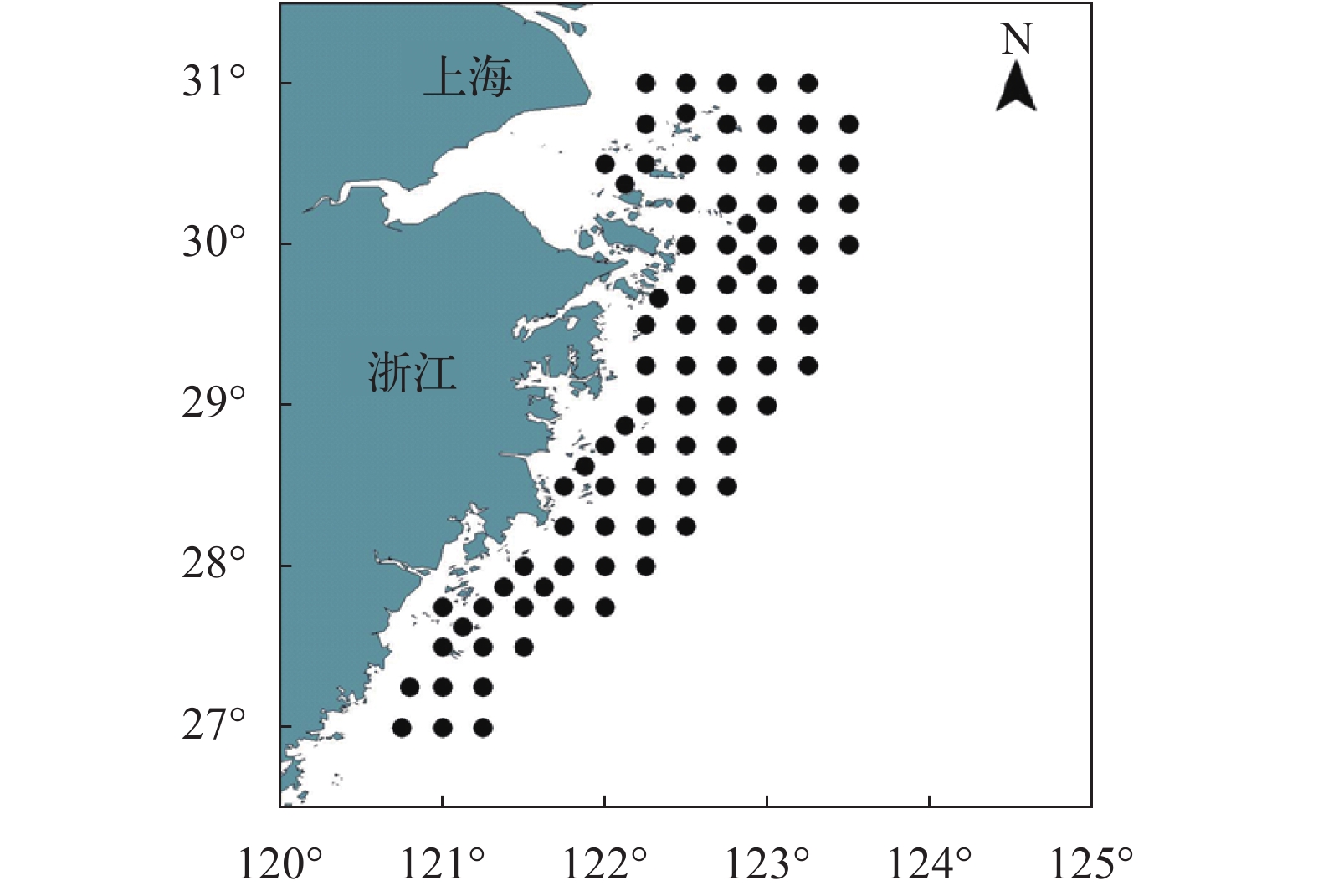
 下载:
下载:
